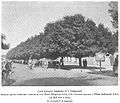Ulmus × androssowii
| Ulmus × androssowii | |
|---|---|
 Uzbekistan Elm, Samarkand | |
| Hybrid parentage | U. minor var. umbraculifera × U. pumila |
| Origin | Uzbekistan |
Ulmus × androssowii R. Kam. , commonly known as the Uzbekistan Elm, is probably an artificial hybrid. According to Lozina-Lozinskaia [1] the tree is unknown in the wild in Uzbekistan, and apparently arose from a crossing of U. densa var. bubyriana Späth (:now Ulmus minor 'Umbraculifera') and the Siberian Elm Ulmus pumila.[2]
Description
The tree grows to a height of 20 m and is distinguished by its very dense spherical crown and pubescent leaves.[3] Its compact branch structure helps the tree conserve moisture.[4]
Pests and diseases
Not known.
Cultivation
The hybrid has been widely planted in southern and western areas of the former Soviet Union, notably along the streets of Samarkand. Cold-hardy, it prefers a rich soil and moderate humidity.
-

U. × androssowii left, U. Bubyriana [ Ulmus minor 'Umbraculifera' (?)] right, Samarkand (1903)
Hybrid cultivars
Ulmus 'Karagatch' is a hybrid cultivar from Turkestan, selected in the early 20th century and said to be either a backcrossing of U. pumila and U. × androssowii or simply a cultivar of × androssowii.
Synonymy
- Ulmus Androssowi: Litv. in Schedae ad Herbarium Florae Rossicae 8: 23, no. 2445, t.2, 1922.
- Ulmus pumila f. androssowii (Litv.) Rehd.
Accessions
- North America
- Morton Arboretum, Illinois, USA. Acc. no. 353-72 (received as U. pumila f. androssowii (Litv.) Rehder).
- Europe
- Grange Farm Arboretum, Sutton St James, Spalding, Lincolnshire, UK. Grafted cuttings acquired 2013. Acc. nos. 1095, 1096.
- Hortus Botanicus Nationalis, Salaspils, Latvia. Acc. nos. 18165, 18166 (as U. pumila f. androssowii, both from Moscow).
- Sir Harold Hillier Gardens, Romsey, Hants. Acc. nos. 2016.0355, 2016.0356.
References
- ↑ Sokolov (1951). Trees & Shrubs in the U.S.S.R (in Russian), 2: 506.
- ↑ Rehder, Alfred (1939). "Rehder, new species, varieties and combinations". Journal of the Arnold Arboretum. 20: 88–89. Retrieved 12 August 2016.
- ↑ Green, Peter Shaw (1964). "Registration of cultivar names in Ulmus" (PDF). Arnoldia. Arnold Arboretum, Harvard University. 24 (6–8): 41–80. Retrieved 20 June 2016.
- ↑ World Digital Library, wdl.org/en/item/5747/
External links
Photographs of and information on Uzbekistan Elm, World Digital Library